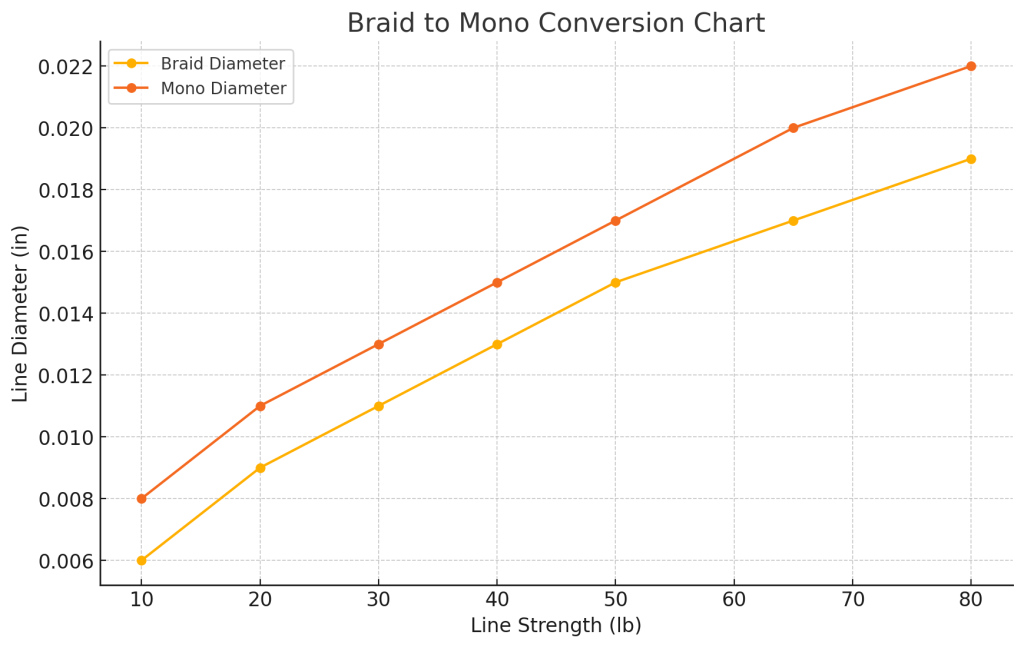Currently Empty: $0.00

When it comes to fishing, the choice of line can significantly impact your success. Two popular options are braided lines (often referred to as “braid”) and monofilament lines (“mono”). However, these two types of lines have different characteristics, making it essential for anglers to understand how they compare, especially when switching from one to the other. This is where a braid to mono conversion chart comes into play.
Why a Braid to Mono Conversion Chart Matters
A braid to mono conversion chart is an essential tool for anglers who switch between these two types of lines. The primary difference between braid and mono lies in their diameters and breaking strengths. Braid is much thinner than mono for the same breaking strength, which can be confusing when trying to match the line to your fishing reel or rod guides. Without a conversion chart, you might end up with a line that doesn’t perform, leading to a less effective experience.
For example, a 30-pound braid has a significantly smaller diameter than a 30-pound mono. If you’re accustomed to using 30-pound mono and decide to switch to braid, simply choosing a 30-pound braid might not be the best option for your setup. The thinner diameter of the braid could cause issues with line management or knot strength. This is where a braid to mono conversion chart comes in, allowing you to match the diameters more closely and ensure a smooth transition.
How to Use a Braid to Mono Conversion Chart

Using a braid to mono conversion chart is straightforward. The chart typically lists various breaking strengths for both braid and mono, along with their corresponding diameters. By comparing the diameters, you can select a braid that closely matches the diameter of the mono you are used to.
For instance, if you usually fish with a 20-pound mono, you might find that a 50-pound braid has a similar diameter. This means you can switch to the stronger braid without significantly altering the line’s performance on your reel. Conversely, if you’re moving from braid to mono, the chart can help you choose a mono line that offers similar handling characteristics as the braid.
Benefits of Understanding
Understanding braid to mono conversion offers several advantages. Firstly, it ensures that your fishing gear is balanced and performs optimally. A properly matched line prevents issues such as line digging into the reel spool, poor casting performance, or difficulty in tying secure knots. Additionally, by selecting the appropriate line diameter, you maintain the intended action of your fishing rod, which is crucial for detecting bites and setting hooks effectively.
Another benefit is the potential cost savings. Braid, while more expensive per yard, tends to last longer than mono due to its resistance to UV damage and abrasion. However, it is not always necessary to use braid for every fishing scenario. By using a conversion chart, you can make informed decisions about when to use braid and when to stick with mono, optimizing your fishing budget.
Historical Significance of Conversion Charts
The need for conversion charts became apparent as braided lines gained popularity. In the early days of braid, many anglers faced difficulties transitioning from mono due to the lack of standardized information. This led to the development of conversion charts by manufacturers and fishing experts, providing a reference point for anglers to make informed decisions.
These charts have evolved over time, becoming more sophisticated and widely available. Initially, they were printed on packaging or shared in fishing magazines, but today, digital versions are easily accessible online. This accessibility has empowered anglers of all skill levels to fine-tune their setups with precision, contributing to better overall fishing experiences.
Factors to Consider Beyond the Chart
While a braid to mono conversion chart is an excellent tool, it’s important to remember that it should not be the sole factor in your decision-making process. Other factors, such as the type of fish you’re targeting, the fishing environment, and personal preference, should also influence your choice of line.
For example, some anglers prefer the low visibility of mono in clear water, while others appreciate the sensitivity and strength of braid when fishing in heavy cover. Additionally, knot strength and ease of tying should be considered, as braid can be more challenging to work with than mono. By combining the information from the conversion chart with your specific fishing needs, you can select the ideal line for your situation.
Common Misconceptions
There are some misconceptions about using braid and mono that anglers should be aware of. One common myth is that braid is always superior to mono. While braid does offer many advantages, such as greater strength and sensitivity, it is not always the best choice for every situation. For instance, mono’s stretch can be beneficial when fishing with certain techniques, such as trolling, where it acts as a shock absorber.
Another misconception is that the thinner diameter of braid means you can spool more line on your reel without any drawbacks. However, overloading your reel with braid can lead to issues like line tangles or improper drag function. Using a conversion chart helps you avoid these pitfalls by guiding you to the right balance between line capacity and performance.
Conclusion
In the world of fishing, having the right tools and knowledge is key to success. A braid to mono conversion chart is one of those indispensable tools that can make a significant difference in your fishing experience. By understanding the relationship between braid and mono diameters and how to use a conversion chart effectively.
Whether you’re a seasoned angler or new to the sport, taking the time to learn about braid to mono conversion will enhance your ability to make informed decisions. This knowledge not only improves your chances of a successful catch but also ensures that you get the most out of your equipment, making every fishing trip more enjoyable and productive.


